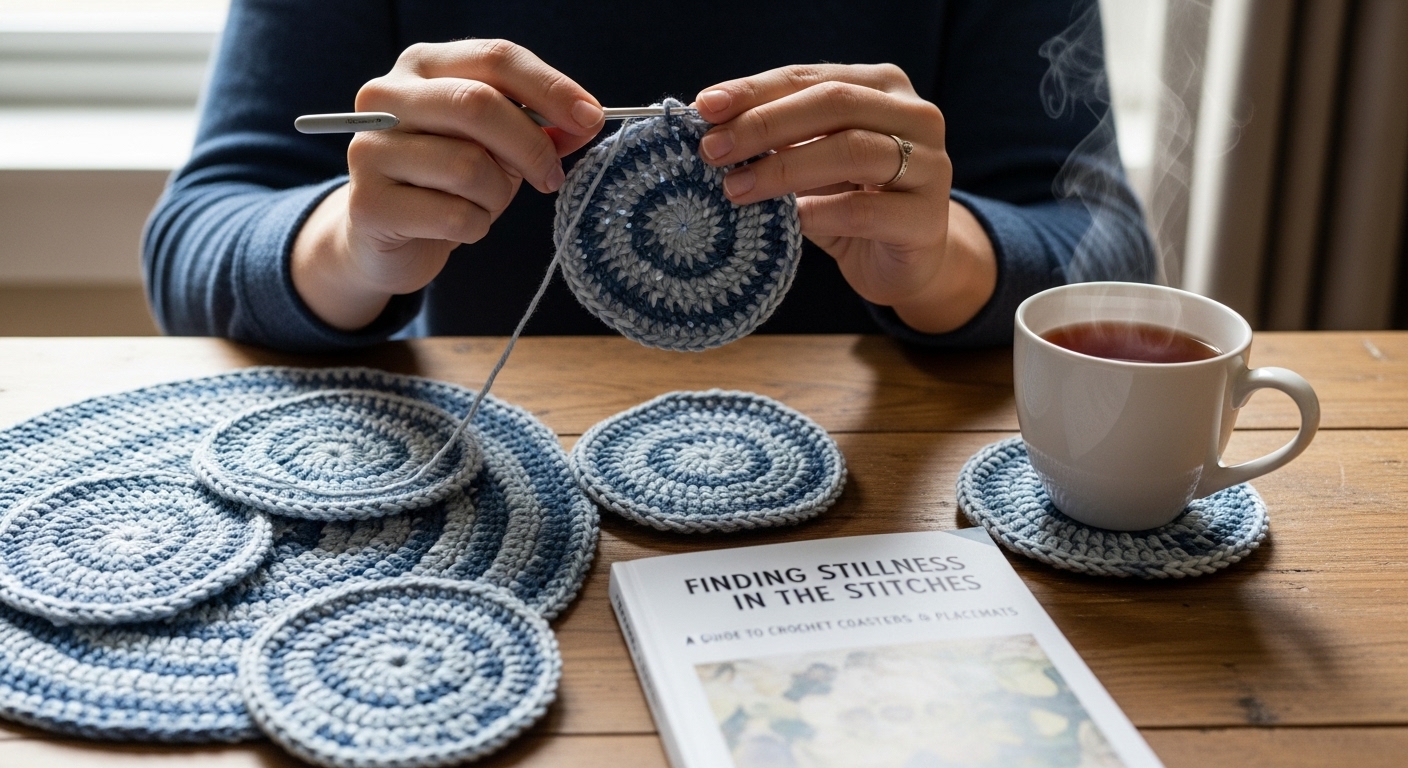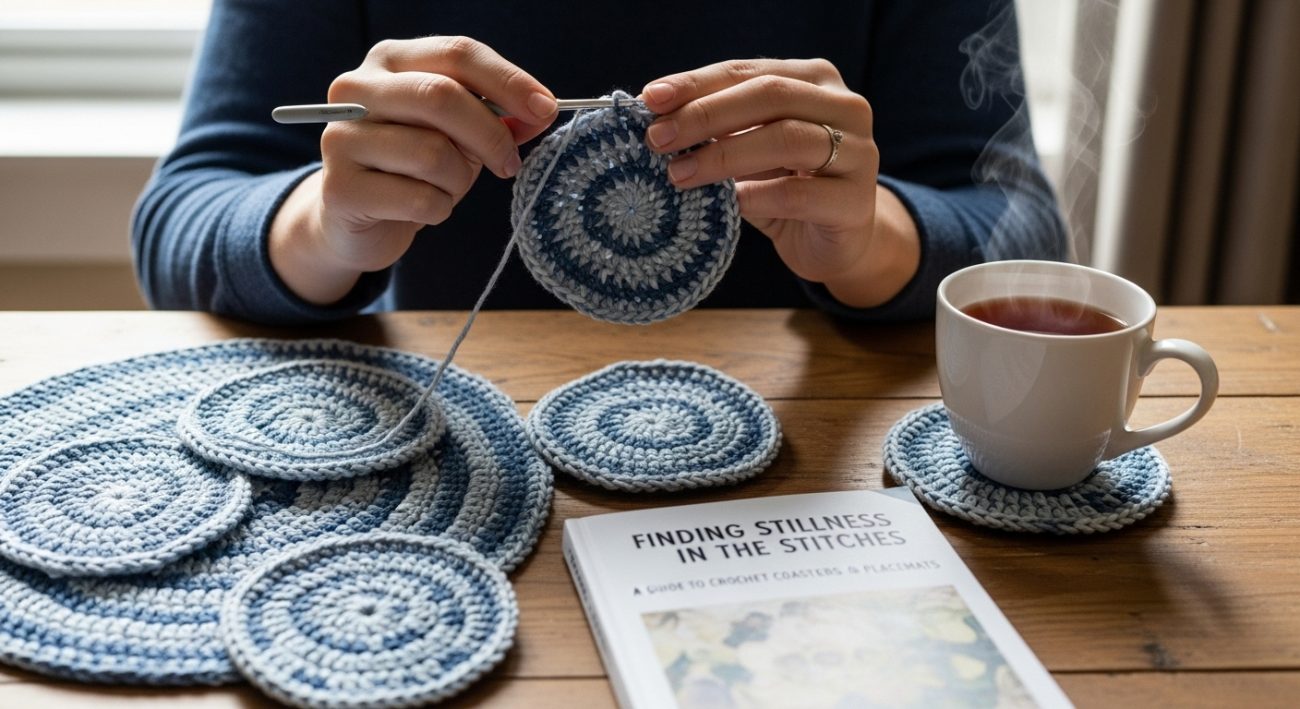Finding Stillness in the Stitches: A Guide to Crochet Coasters and Placemats
In the gentle rhythm of a hook moving through yarn, there is a unique form of quiet. Crochet, for many of us, is more than a hobby; it’s a practice in mindfulness, a way to create something beautiful and functional from a simple strand of fiber. And within this craft, few projects offer the immediate satisfaction and peaceful repetition of creating coasters and placemats.
These small, domestic items are the perfect canvas for experimentation and tranquility. They are quick to complete, allowing you to see the fruits of your labor in a single sitting. They are practical, adding a touch of handmade warmth to your daily rituals of coffee, tea, and meals. And they are forgiving, making them ideal for both the seasoned stitcher seeking a meditative project and the beginner looking to build confidence.
Let us explore some gentle ideas and patterns to inspire your next session of quiet creation.

The Simple Round Coaster: A Foundation of Calm
Every crocheter’s journey often begins with a circle. The simple round coaster is a foundational project that never loses its charm. Its construction is a lesson in geometry and growth, each round building upon the last to create a perfect, flat circle.
To achieve this, the magic ring technique is your best friend. It creates a tightly closed center, eliminating any unsightly hole. From there, you work increases in a consistent pattern—typically six single crochets in the ring, then two in each stitch for the next round, and so on. The key to a flat circle is to increase evenly. A good rule of thumb is to increase by the same number of stitches each round (e.g., 6, 12, 18, 24).
But the beauty of the simple round coaster lies in its versatility. You can use a sturdy, worsted-weight cotton yarn for its absorbency and durability. Choose a solid, calming color like sage green, soft oat, or a muted clay. As your hook moves in that familiar spiral, you’ll find a rhythm that soothes the mind. This project isn’t about complexity; it’s about the steady, reassuring progression of stitches, creating a small object of purpose and peace.
Exploring Textures: The Granny Square and Beyond
If the round coaster is a meditation, textured patterns are a gentle song. Introducing different stitches can transform a basic coaster into a tactile delight. The classic Granny Square, with its clusters of double crochets separated by chain spaces, is a timeless choice. It works up quickly and is wonderfully forgiving. A set of Granny Square coasters in a harmonious color palette can look like a collection of miniature, cozy quilts for your table.
Beyond this classic, consider the humble but beautiful Wafer Stitch (or puff stitch). This stitch creates a soft, nubby texture that is not only visually interesting but also functional, providing a little extra grip for your glass or mug. Working a series of puff stitches into a square or hexagon pattern is a deeply satisfying process. You feel the texture build beneath your fingers with each soft “puff.”
Another serene option is the linen or moss stitch. This stitch, a simple alternation of single crochet and chain stitches, creates a tight, dense, and beautifully woven-looking fabric. It’s perfect for placemats, as it lays flat and is very sturdy. The repetitive, almost mechanical nature of the moss stitch is incredibly calming, making it an excellent project for quiet evenings.
Shapes and Forms: Hexagons, Squares, and Leaves
Why should coasters only be circles? Gently expanding your repertoire to include different shapes can be a refreshing creative exercise. The crochet hexagon, for instance, has a lovely, honeycomb-like charm. Its six sides offer a new geometric pattern to learn, yet its construction is just as rhythmic as a circle.
You can also create simple squares with a delicate lace edging, or even venture into organic forms. A leaf-shaped coaster is a beautiful way to bring a touch of nature to your table. These often use basic increases and decreases to form the leaf’s shape, and a simple picot edging can mimic the veining. Working on a project that mirrors the natural world can feel particularly grounding.
For placemats, the rectangle is the most practical shape. You can work them in rows, using any stitch pattern you love—from the simple single crochet to the more elaborate basketweave stitch. The process becomes a long, tranquil journey of back-and-forth rows, a perfect companion for listening to soft music or the sounds of a quiet afternoon.
A Note on Yarn and Color: Choosing Your Palette of Peace
The materials you choose are integral to the calm nature of your project. For coasters and placemats, fiber content is key for functionality. Cotton yarn is often the preferred choice. It is absorbent, durable, and holds its shape well when washed. It also has a lovely, substantial feel that lends itself well to home decor items.
When it comes to color, let your intuition guide you towards tranquility. A monochromatic scheme using different shades of a single color—like cream, beige, and sand—can create a look of serene sophistication. A palette inspired by the sea, with soft blues, greens, and sandy neutrals, can evoke a sense of calm. Alternatively, working with a single, solid, muted tone allows the beauty of the stitch pattern itself to take center stage. There is a quiet confidence in a beautifully made object that doesn’t need to shout with color.
Weaving in the Ends: A Final Moment of Mindfulness
As you finish your last stitch and fasten off the yarn, your work is not quite complete. Weaving in the ends is often seen as a chore, but it can be the final, mindful act of the creation process. Instead of rushing through it, see it as a time to slowly and carefully secure your work, to ensure its longevity and neatness. It is a quiet acknowledgment that every part of the process, even the seemingly mundane, has value.
Place your newly finished coaster under your cup. Set the table with your handmade placemats. There is a profound sense of quiet accomplishment in using something you have created with your own hands. These items, born from patience and repetition, carry the calm energy of their making into your home. They are more than just fabric and thread; they are small, daily reminders of the peace that can be found in the simple, intentional act of creating.
